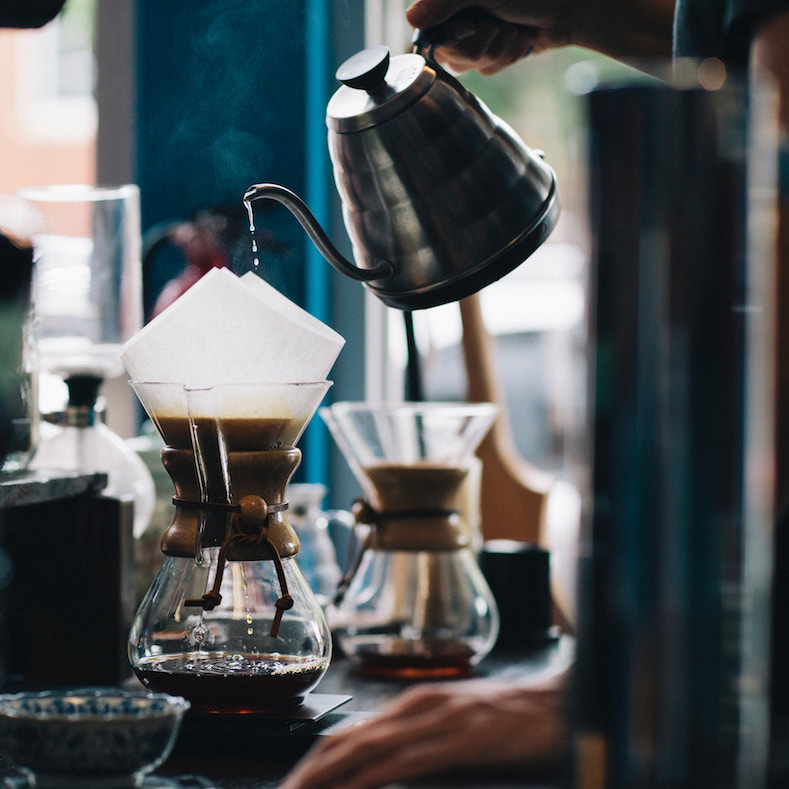
Why Narratives Transform Customers’ Experiences
BY DEVIN MOORE
“Stories are data with a soul.” – Brene Brown
During a recent vacation on the Oregon coast, I observed several family members who were perplexed by the coffee maker in our rental house.
 The lid screwed on to the carafe (unlike most lids that just click in), and it had arrows indicating things like “pour” and “brew.” The carafe itself was stainless steel, which made it impossible to see the fill level. After a few disastrous attempts at making coffee that involved the carafe overflowing onto the counter, they realized the lid must always be screwed into the “brew” position to allow the coffee to flow into the carafe during brewing, but then it must then be detached and re-screwed into “pour” position to get coffee into a mug. As my cousin put it, “I need caffeine to figure out this coffee maker, but I can’t get caffeine until I’ve figured it out.” I should note that my cousin is an experienced barista.
The lid screwed on to the carafe (unlike most lids that just click in), and it had arrows indicating things like “pour” and “brew.” The carafe itself was stainless steel, which made it impossible to see the fill level. After a few disastrous attempts at making coffee that involved the carafe overflowing onto the counter, they realized the lid must always be screwed into the “brew” position to allow the coffee to flow into the carafe during brewing, but then it must then be detached and re-screwed into “pour” position to get coffee into a mug. As my cousin put it, “I need caffeine to figure out this coffee maker, but I can’t get caffeine until I’ve figured it out.” I should note that my cousin is an experienced barista.
Developing a narrative about how users will interact with a finished product can be one of the most powerful (and often overlooked) processes a designer can use to produce the best work. In its simplest form, a narrative is simply an accounting of events, or telling a story. A narrative brings experiences to life, allowing us to anticipate how users will interact with a product at every sensory level. Here at Big Bang narratives have become a key part of our process for developing product experiences; we use this powerful method to understand who the user of the product is, and envision their interactions with it.
Stories can create connections; carefully explain a selected set of experiences; represent a specific viewpoint; and can help the various voices involved in the design process be represented, heard, and addressed during the process. And because accounting for these voices during the design process can become unwieldy, narratives help keep everything organized.
Beyond this, narratives are used as a tool to discover, evaluate, and maintain an experience. They give us a tangible vision of how the product is going to be used, which is critical information to have during the foundation phase of design. During the foundation, narratives are used to bring together user research, market evaluations, and competitor analysis. This process uncovers existing holes, and opportunities for the product.
And as the project progresses through its various phases, the narrative then shifts into its next role as an evaluator and reminder. As concepts are being developed the narratives are used to reign in, evaluate, or change them. Narratives continue to act as evaluators throughout the design process, and are paramount in helping make small decisions that tailor the experience. Finally, the release phase of the project uses the narratives to craft an elevator pitch. They represent the stakeholders and make it clear how the experience was formed by them.
In the example of the coffee maker, developing a narrative about who was going to use the product and when might have triggered different design decisions. Would the designers have still gone with an opaque carafe? Or a tricky lid that needed to be adjusted frequently to complete basic coffee-making tasks? Maybe not. But it serves as a good reminder that cold, hard data needs to be tempered with the warm, human experience aspect of design. And developing narratives are the best way to do that.
Wham!
Related: How to Create Effective Swim Lanes for Your Next Big Team Project
